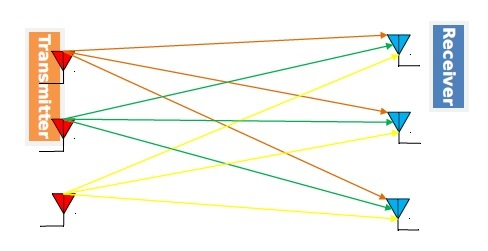
 Data Structure
Data Structure Networking
Networking RDBMS
RDBMS Operating System
Operating System Java
Java MS Excel
MS Excel iOS
iOS HTML
HTML CSS
CSS Android
Android Python
Python C Programming
C Programming C++
C++ C#
C# MongoDB
MongoDB MySQL
MySQL Javascript
Javascript PHP
PHP
- Selected Reading
- UPSC IAS Exams Notes
- Developer's Best Practices
- Questions and Answers
- Effective Resume Writing
- HR Interview Questions
- Computer Glossary
- Who is Who
Multiple Input Multiple Output (MIMO)
In wireless communications, when multiple antennas are used both at the transmitting end as well as the receiving end, the configuration is said to be multiple input, multiple output or MIMO. MIMO helps in sending and receiving multiple data signals simultaneously over the same radio channel. MIMO is a smart antenna technology, the other popular technology being multiple input, single output (MISO) and single input, multiple output (SIMO).
The following diagram shows MIMO configuration −

Advantage of MIMO over Traditional Wireless Systems
In traditional wireless communication systems, a single antenna is used at the transmitter site, and another single antenna is used at the receiver site. This may give rise to multipath effects. Multipath effects arise when obstructions in the line of propagation scatters communication waves, due to which the source signal takes multiple paths to reach the destination. The scattered portions of the signal arrives late and causes transmission problems like fading, intermittent reception, reduction in data speed, more errors etc. When two or more antennas are used, the trouble caused by multipath wave propagation is eliminated. The signals received by antennas at the receiver site are combined to generate a more accurate signal.
Applications
The possible area of applications of MIMO technology are −
- digital television (DTV)
- wireless local area networks (WLANs)
- mobile communications
- home networks

